Editors of this issue: Antanas Klimas

|
LITUANUS
LITHUANIAN QUARTERLY JOURNAL OF ARTS AND SCIENCES
Volume 20, No.3 - Fall 1974
Editors of this issue: Antanas Klimas Copyright © 1974 LITUANUS Foundation, Inc.
|

|
THE ART OF PRANAS
Pranas Gailius:
Lithuanian Artist in Paris
 The artistic life of Pranas began in Paris. Since 1955 every year he participated in various salons of this famous city with his paintings, gouaches, water colors and drawings. At that time, when Pranas started to express himself as an artist, in Paris there was a very popular style called tachisme (from the French 'to stain, spot, blot'). The art works of Pranas at the beginning have a touch of this style, with the difference that his works are more reminding of nature, especially with the elements of the plant and animal world. A very good example of his nature world in this style is "Metamorphose II." From 1962 Pranas concentrated mostly on graphics, which resembles his paintings with somewhat more or less abstract forms. Some of his graphic works represent the objective world and therefore the artist calls them by realistic titles: "Good bye Chryselide," "The Beautiful Spring," "The Tarantula." The works that represent the non-objective world, Pranas gives them
the names like "Intra Muros," "Kammerbloc" and "Incabloc."
The artistic life of Pranas began in Paris. Since 1955 every year he participated in various salons of this famous city with his paintings, gouaches, water colors and drawings. At that time, when Pranas started to express himself as an artist, in Paris there was a very popular style called tachisme (from the French 'to stain, spot, blot'). The art works of Pranas at the beginning have a touch of this style, with the difference that his works are more reminding of nature, especially with the elements of the plant and animal world. A very good example of his nature world in this style is "Metamorphose II." From 1962 Pranas concentrated mostly on graphics, which resembles his paintings with somewhat more or less abstract forms. Some of his graphic works represent the objective world and therefore the artist calls them by realistic titles: "Good bye Chryselide," "The Beautiful Spring," "The Tarantula." The works that represent the non-objective world, Pranas gives them
the names like "Intra Muros," "Kammerbloc" and "Incabloc."
During the last decade Pranas became a graphic art expert as he himself says: "Being a born graphic, not formed by any school, I was attracted by the engraved pictures. Streaks, strokes, lines, white are so expressive that they make the base which I could call my technique. But I did not care only for technique or aesthetics as such. Only the need to express oneself gives the impulse for the technique to which I have to adapt myself."
Pranas' latest colored graphic works are called "Incabloc." The artist himself defines it: "Incabloc" to my understanding is an object incorporated in the block, but not the object in itself. My first aim was to give a graphic contour with a maximum expression which I call block. I wished that, line, the contour of the block, encircling the block and enclosing around the form, would express through its windings, sinuousnesses, the maximum of the surrounding space and that it would leave unprinted area, in the block itself for the tempered relief. In "Incabloc" the artist selects bright, sharp and contrasting colors—black, red, white. His colored graphic works, according to the artist, include a combination of expressive lines, a play of dynamic forms, a reality parallel to the illusions."
Pranas' "Incabloc" printed relief's are pressed from the etchings with a hand-press by the artist himself. "To me, Pranas says, general atmosphere is experienced from a distance. Contrary to the perspective principles, it is taken apart in pieces by the feeling, as if you put all your feelings in front of you and you turn them to the optical perception. My works are so soaked with vitality, in which the skillful technique bows to the expressive needs."
The Paris art critics write about Pranas art works: "With slow changes and dramatic intensity Pranas condenses the whole world in a small space. This young Lithuanian for the first time in Paris shows the fruits of his obstinate seven years' work. His precisely clean technique of graphics — dry-point and etchings — search not only to fix reality by those material means of which the artist is aware, but also to create a powerful and sparkling intensity of playful values."
Besides the above mentioned graphic art works, the artist Pranas has two great artistic achievements, the two illustrated books of the poet Milosz: "La Mer" (The Sea) and "The Lithuanian Suite" by choosing a longitudinal form for his books, like the spacious horizontal sea and by using free lithographic technique by applying ink in the planes and concaves, he is able to express the changing characteristics of the theme.
In his graphic art works, especially in his "Incabloc," Pranas reveals himself as an artist, having his very own characteristic technique, a creative artistic expression repeated nowhere else.
Saulë Jautokaitë, Chicago
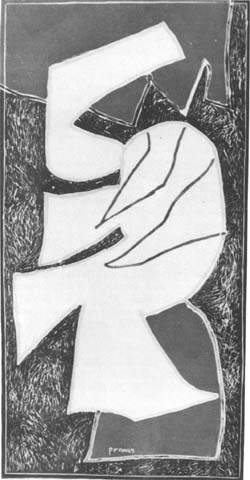
PRANAS: INCABLOC VI
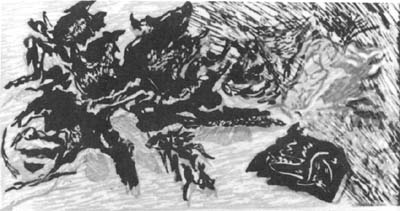
PRANAS: METAMORPHOSE II
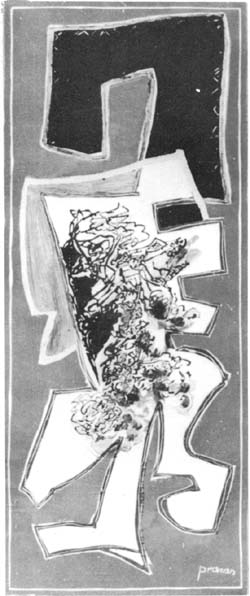
PRANAS: INCABLOC II
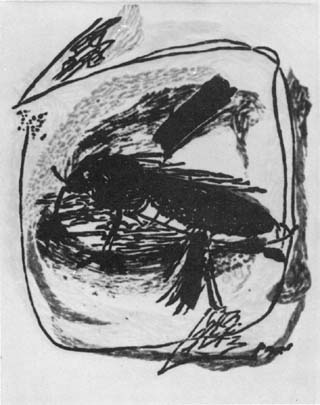
PRANAS: PRINTEMPS JOLI (The Beautiful Spring)
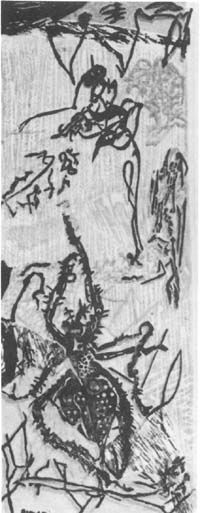
PRANAS: LA TARENTULE (The Tarantula)
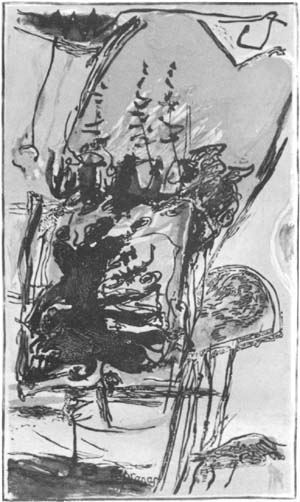
PRANAS: GOOD BYE CHRYSELIDE
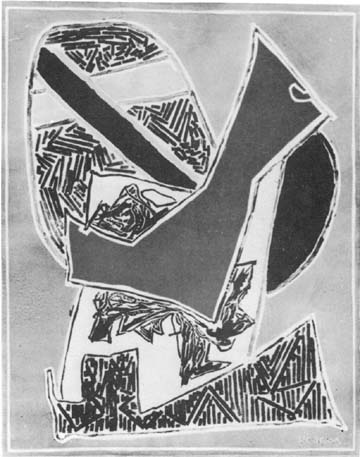
PRANAS: KAMMERBLOC XI
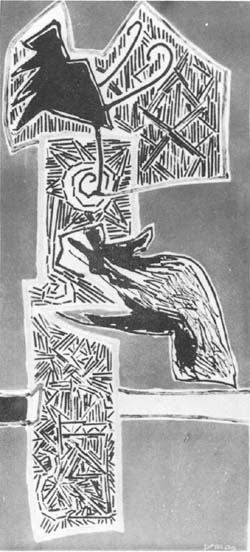
PRANAS:INCABLOC I
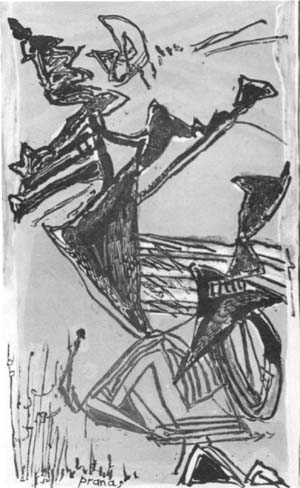
PRANAS: SOLO ORANGE
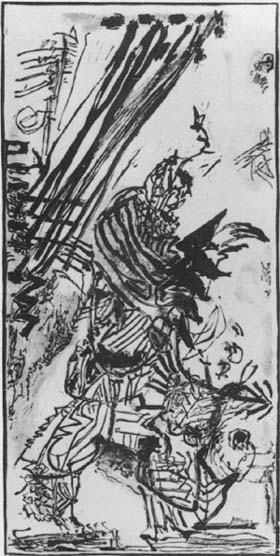
PRANAS: SURFACE EMUE XII
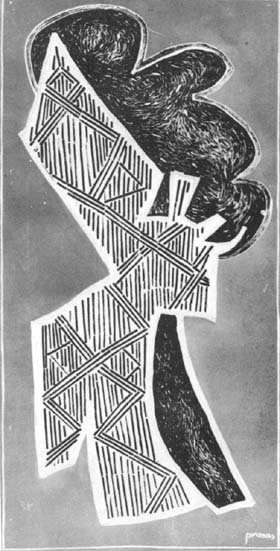
PRANAS: INCABLOC IV
Principal Exhibits of
Pranas Gailius
Peinture — Oil
Galerie du HAUT PAVE, Paris 1955; Galerie LA VOUTE (MARCEL LENOIR), Paris 1957; Galerie BELLECHASSE, Paris 1958, 1959, 1960; Galerie DUMAY, Paris 1963; ČIURLIONIS ART GALLERY, Chicago 1963; Galerie DUMAY, Paris 1964; Galerie MOTTE, Geneve 1966.
Gravure — Graphics
Galerie LA NOUVELLE GRAVURE — Série "METAMORPHOSES," Paris 1963; BIBLIOTHEQUE NATIONALE, Cabinet des Estampes "Gravure Contemporaine", Paris 1963; Galerie LA NOUVELLE GRAVURE — Série "INTRA MUROS", Paris 1965; BIBLIOTHEQUE NATIONALE, Cabinet des Estampes 'Gravures en noir at blanc", Paris 1965; Galerie LE FINAL "OEUVRE GRAVE", Paris 1966; "JEUNES ARTISTES GRAVEURS", Tokio 1966; Galerie HORN, Luxembourg 1966; Galerie ARIANE — Séries "SUITE LITHUANIENNE", "INTRA MUROS", Goteborg 1967; LA MAISON PRANCAISE, New York University, New York 1968; BAUKUNST "LA GRAVURE PRANCAISE DE 1930 A NOS JOURS", Cologne 1968; Galerie PHILIPPE SAINTHONORE, Paris 1968; Galerie de Seine — Marthe NOCHY — Les Elements: l'Aau, Paris 1970; ART & INVESTIGATION "INCABLOCS", Paris 1972; ČIURLIONIS ART GALLERY "INCABLOCS" "KAMMERBLOCS", Chicago 1973.
Aquarelles - Dessins — Water Colors
Galerie LE SOLEIL DANS LA TETE, Paris 1959; INSTITUT FUER AUSLANDSBEZIEHUNGEN, Stuttgart, Berlin, Munich 1960; Galerie DUMAY, Paris 1962.
Salons — Galleries
SALON DE LA JEUNE PEINTURE, Paris 1963; SALON DES ILLUSTRATEURS DU LIVRE, Paris 1963; SALON DE LA JEUNE GRAVURE CONTEMPORAINE, Paris 1965, 1968, 1970; SALON DE MAI, Paris 1966, 1968, 1969, 1972; SALON DES REALITES NOUVELLES, Paris 1966.